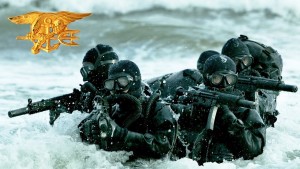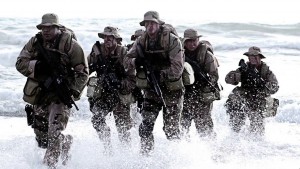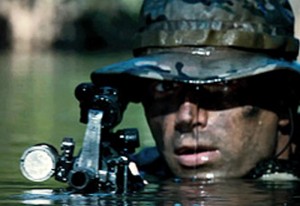Any place where there are currently U.S. troops, you’ll find that SEALs are either there now or were there first. The role that Navy SEAL teams play revolves around getting in and out quickly and without being seen, gathering intelligence, destroying targets, and performing rescues, among other things.
U.S. Special Operations Forces, which includes elite commando forces from each branch of the military, such as the Navy SEALs, Army Rangers, Green Berets, and others have become critical to many U.S. military successes over the past decade. Each branch of the military has its own specially trained teams that can operate in any situation and perform whatever task it takes to get the job done.
What does it take to become a Navy SEAL? Even SEAL instructors can’t predict who will make it all the way. The common trait instructors see in future SEALs can’t really be defined, they just call it “fire in the gut.” You either have it or you don’t.
In this article, you’ll see how Navy SEALs operate and what they do, the amazing determination it takes to become a SEAL, the widely varied skills they need, and the types of equipment they use on missions.
About Navy SEALs
The SEAL acronym stands for Sea, Air, and Land, which identifies the elements in which they operate. SEALs work in small units — often one to two men, but sometimes in a platoon comprised of up to 16. They are trained to perform specific tasks under any type of circumstance and in any environment. Their training takes place in the desert, the jungle, in extreme hot and cold weather, and in urban areas.
SEAL missions require detailed planning and precise execution. SEALs are trained to perform missions that fall into five main categories:
KEEP READING BELOW
- Unconventional Warfare(UW) – Using guerilla warfare tactics in battle. Guerilla warfare is characterized by small, mobile combat groups that operate using often “unorthodox” battle methods like destroying enemy supplies, creating diversions, ambushing small enemy units, demolitions, and other “hit and run” types of operations.
- Foreign Internal Defense(FID) – Training given to foreign nationals in order to build relationships. During Operation Desert Storm, Navy SEALs trained 13 Kuwaiti operators in maritime infiltration techniques in order to set up a secret meeting with local resistance contacts within Iraq-occupied Kuwait City.
- Direct Action(DA) – Moving against an enemy target. This may include assaults on land- or water-based targets, hostage rescues, ambushes, etc.
- Counterterrorism(CT) – Includes direct action against terrorist operations, antiterrorist actions for preventing terrorist acts, and protecting citizens and troops.
- Special Reconnaissance(SR) – Includes conducting preliminary surveys to gather information, manning observation posts, and other types of surveillance, both overt and covert, where the goal is to gather information.This may include gathering hydrographic data (beach and water surveys) for landings or following an enemy unit and reporting its position.
When SEALs aren’t deployed, they’re in constant training, both to hone basic skills and to learn new skills and techniques that will make a difference when they are deployed.
The above categories overlap when it comes to actual missions, but these are the basis of SEAL training: to be expert in the skills required to perform these various tasks.
SEAL STATS
- Only about 25 percent of trainees make it through training to become SEALs.
- A SEAL has never been left behind on a mission.
- A SEAL has never been taken prisoner.
- There are currently about 2,290 active-duty SEALs.
In 1941, after the Japanese bombed Pearl Harbor, U.S. troops were forced to invade Japanese territory by sea, often facing landminesand attacks from unseen enemies. As a countermeasure to these hazards, the U.S. Navy began creating teams that were specially trained to go safely ashore and clear the path of obstacles and other hazards and return intelligence on enemy locations. These teams of six men were called Naval Combat Demolition Units. Their training was heavy in physical strengthening and included carrying heavy loads, swimming, running, and maneuvering in small boats. Their training also included handling explosives. Eventually, they evolved into Underwater Demolition Teams (UDT).
The UDTs were organized in 1943. Also known as frogmen, they were responsible during the Korean War for swimming to shore before an invasion and blowing up obstacles in their path, clearing the way for the amphibious U.S. invasion. They also destroyed important targets like bridges and tunnels.
In the 1960s, the Soviet Union’s ally, North Vietnam, was fighting against a U.S. ally, South Vietnam. President Kennedy wanted to send in small teams of guerrilla fighters to help South Vietnam. With the Army’s Green Beret unit already set up, it was time for the Navy to create its own Special Operations unit. Building on the training of the UDTs, the Navy SEALs (an acronym for Sea, Air, and Land) were created. Their training readied them for the work ahead in the jungles, coasts, and rivers of Vietnam. Their task was to go behind enemy lines and raid enemy camps, sabotage supplies, cut off enemy communications, and destroy stored ammunitions. They were very successful in their missions.
With the Vietnam War ending without victory, many cuts were made in military spending, and the number of Special Forces units were in many cases cut in half. The success of the SEALs in Vietnam, however, proved their value.
Hooyah! — the war cry of the Navy SEALs — becomes an automatic response for SEALs during the torturous SEAL training. While there may be other variations in meaning, “hooyah” generally means “yes,” “understood,” and “I’m not letting this evolution get the best of me.” (Evolution is the term used for each event in the training schedule.)
SEAL training is brutal. It takes over 30 months to train a Navy SEAL to the point at which he will be ready for deployment. The SEALs that emerge are ready to handle pretty much any task they could be called on to perform, including diving, combat swimming, navigation, demolitions, weapons, and parachuting. The training pushes them to the limit both mentally and physically in order to weed out those who may not be able to successfully complete the demanding missions and operations with which SEALs are faced. The types of stresses they endure during BUD/S (Basic Underwater Demolition/SEAL) are the same stresses they will endure as SEALs. If they can’t withstand it when lives aren’t on the line, chances are good they won’t be able to withstand it when lives are at stake.
From day one in SEAL training, trainees are taught the importance of teamwork. Focus is not on the individual. The fact that the SEALs have never left another SEAL behind on a mission is a testament to this belief system. Throughout their training, they learn more and more why teamwork is necessary in the type of work they will soon be entering: SEALs are performing tasks that may not be possible for a single man to accomplish, but can be possible for a team composed of men who have the same training and skills. Their success depends on what they can do together as a team.
Navy SEAL Requirements
Entering training to become a Navy SEAL is voluntary. Anyone can volunteer, and officers and enlisted men train side by side. In order to enter SEAL training, however, they do have to meet certain requirements. Those wishing to volunteer for SEAL training have to:
- be an active-duty member of the U.S. Navy
- be a man (women aren’t allowed to be Navy SEALs)
- be 28 or younger (although waivers for 29- and 30-year-olds are possible)
- have good vision — at least 20/40 in one eye and 20/70 in the other (corrective surgery is also possible)
- be a U.S. citizen
- pass the Armed Services Vocational Aptitude Battery(ASVAB)
- Pass a stringent physical screening test that includes the following procedure: swim 500 yards in 12.5 minutes or less, followed by a 10-minute rest; do 42 push-ups in under two minutes, followed by a two-minute rest; do 50 sit-ups in under two minutes, followed by a two-minute rest; do six pull-ups, followed by a 10-minute rest; run 1.5 miles in boots and long pants in less than 11.5 minutes
Once a potential SEAL qualifies for training, the real fun starts.
SEAL Training: BUD/S
Basic Underwater Demolition/SEAL (BUD/S) training is divided into several phases:
- Indoctrination
- Basic Conditioning
- SCUBA training
- Land-warfare training
There is also the infamous Hell Week, which takes place toward the end of Basic Conditioning.
BUD/S lasts seven months. The initial indoctrination comprises five weeks of learning the expectations and ways of Navy SEALS. More important, it is a time to prepare physically and mentally for what’s ahead.
Once indoctrination is complete, the remaining time is broken down into eight weeks of basic conditioning, eight weeks of SCUBA training, and nine weeks of land-warfare training. The training takes place at the Naval Amphibious Base at Coronado, CA.




